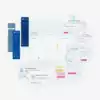Designing the UI backbone for growth
Effex helps R&D teams in the chemical industry run smarter experiments, so they waste less time and money testing the wrong things. Effex had nailed the core functionality. But as they prepared to scale, it became clear the UI couldn’t keep up.
Designed by engineers, the product had grown unevenly. Users found it hard to navigate, and new features only added to the chaos. They didn’t need a full redesign, just a smart, structured way to make the experience feel as solid as the tech behind it.
How we helped
- Map out how users move through the product
We started by mapping key user flows, like how a scientist searches for and sets up an experiment. These flows gave us a blueprint of how people interact with the platform. It helped us spot friction points: where users got stuck, what was confusing, and what could be simplified or removed. - Redesign the key screens to show what’s possible
We focused first on the Catalog Search: a high-traffic screen used across the app. Instead of going straight into final designs, we explored a few different layout and interaction options. That gave the Effex team a clearer view of what the future UI could look like, and helped them make informed trade-offs based on performance, usability, and visual appeal. - Build the foundations for scalable design
We didn’t just clean up individual screens: we built a design system. Starting with a colour palette and basic UI components, we created reusable elements and visual patterns. That gives the Effex team a practical toolkit to build and scale consistently, without reinventing the wheel for every new feature.


What changed (and why it matters)
-
Effex now has a UI that can support growth
The structure, clarity, and consistency are there, even as more features and users are added. -
Reusable components save time
With a clear system in place, the team can roll out new screens faster, without going off-course. -
The product feels more polished and professional
Which helps with onboarding, user confidence, and sales conversations.